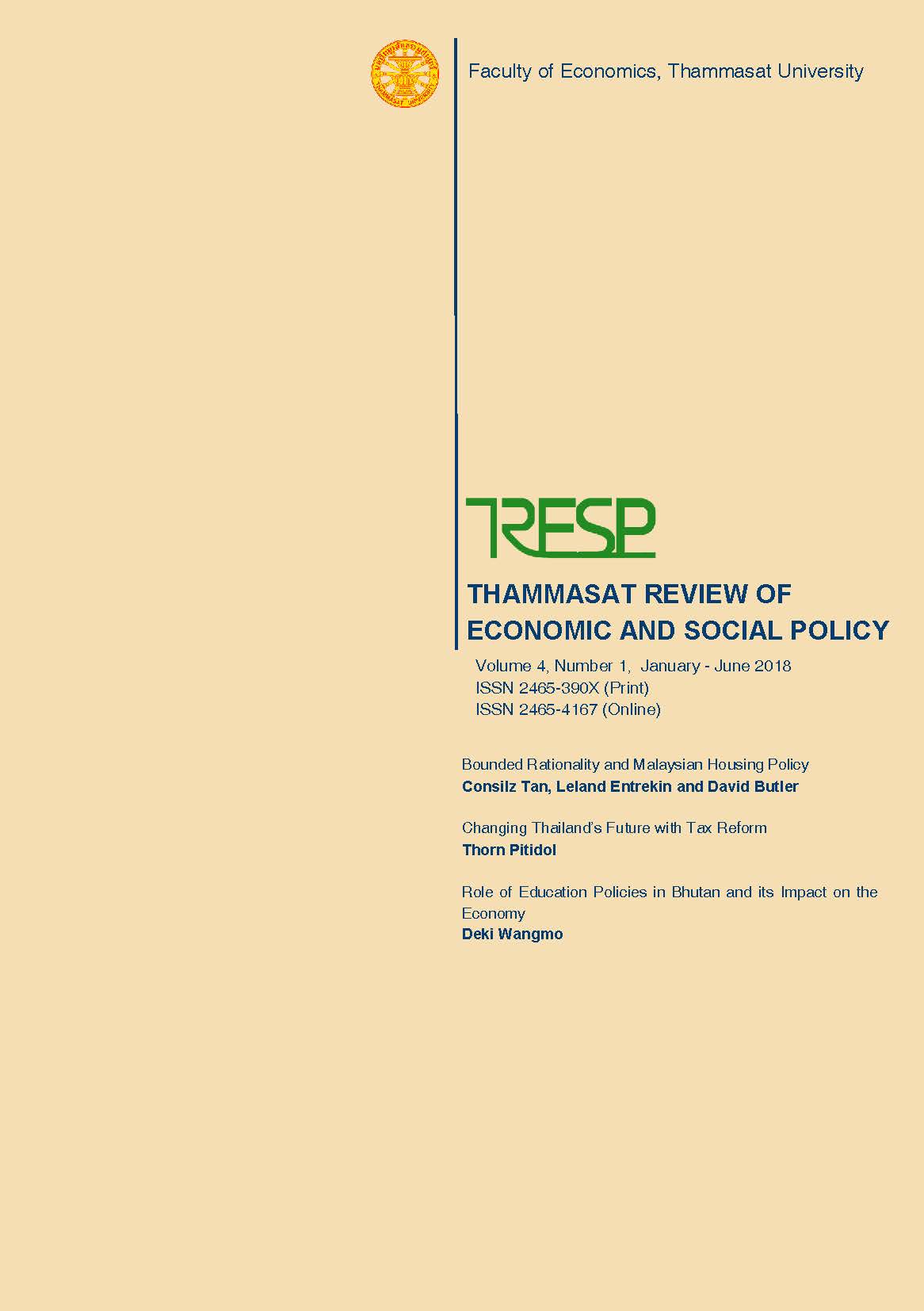Bounded Rationality and Malaysian Housing Policy
DOI:
https://doi.org/10.14456/tresp.2018.1Keywords:
Behavioural economics, Decision making, Real estate investmentAbstract
The investment decision in real estate markets is becoming more challenging, due to rising property prices and the limited purchasing power of home buyers. There are numerous studies and statistics focused on property prices, mortgage eligibility, and lifestyle concepts. However, there is limited research on understanding the individual investors’ decision-making behaviour. This study aims to explore the investment decision in real estate markets by understanding both rational and boundedly rational behaviour of individual investors. We find that individual investors are affected by cognitive biases such as anchoring, endowment effect, loss aversion, and herding. Nonetheless, they are motivated by rational goals such as capital gain, long term investment, rental yield, and wealth accumulation. Our findings can assist Malaysian housing policy to achieve sustainability in the housing industry.
References
Ariely, D., Huber, J. & Wertenbroch, K., (2005). When Do Losses Loom Larger Than Gains. Journal of Marketing Research, 42, 134-138.
Avery, C. & Zemsky, P., (1996). Multi-Dimensional Uncertainty and Herd Behavior in Financial Markets. INSEAD Working Paper Series. INSEAD, Fontainebleau, France.
Banerjee, A.V., (1992). A Simple Model of Herd Behavior. The Quarterly Journal of Economics, 107, 797-817.
Bargh, J.A., (1997). The Automaticity of Everyday Life. In: Robert S and Wyer J (ed.) The Automaticity of Everyday Life. Mahwah, N.J.: Lawrence Erlbaum Associates.
Bell, D. E. (1982). Regret in Decision Making under Uncertainty. Operations Research, 30, 961-981. Brueckner, J.K., (1997). Consumption and Investment Motives and the Portfolio Choices of Homeowners. Journal of Real Estate Finance and Economics, 15, 159- 180.
Camerer, C.F. & Fehr, E., (2006). When Does "Economic Man" Dominate Social Behavior. Science, 311, 47-52.
Carmon, Z. & Ariely, D. (2000). Focusing on the Forgone: How Value Can Appear so Different to Buyers and Sellers. The Journal of Consumer Research, 27, 360-370.
Case, K.E. & Shiller, R.J., (1988). The Behavior of Home Buyers in Boom and Post Boom Markets. National Bureau of Economic Research NBER Working Paper No. 2748.
De Bondt, W. F. M. & Thaler, R. H. (1995). Financial Decision-Making in Markets and Firms: A Behavioural Perspective. In: R. Jarrow and et as. (ed.) Handbook in Operations Research and Management Science. Elsevier Science B.V.
Diaz III, J., (1998). The First Decade of Behavioral Research in the Discipline of Property. Journal of Property Investment & Finance, 17.
Einhorn, H. J. & Hogarth, R. M. (1981). Behavioural Decision Theory: Processes of Judgment and Choice. Annual Review Psychology, 32, 53-88.
Gallimore, P., Hansz, J.A. & Gray, A., (2000). Decision making in small property companies. Journal of Property Investment & Finance, 18, 602-612.
Genesove, D. & Mayer, C., (2001). Loss Aversion and Seller Behavior: Evidence from the Housing Market. Quarterly Journal of Economics, 116, 1233-1260.
Grover, P. & Singh, L.K. (2015). Study on Behavioural Factors Influencing Investment Decision in Real Estate: A Case Study of Udham Singh Nagar (Uttrakhand). International Journal of Engineering Technology, Management and Applied Sciences, 3(7), 150-158.
Hirshleifer, D. & Teoh, S.H., (2001). Herd Behaviour and Cascading in Capital Markets: A Review and Synthesis. European Financial Management, 19, 25-66.
Kahneman, D., (2003). Maps of Bounded Rationality: Psychology for Behavioral Economics. The American Economic Review, 95, 1449-1475.
Kahneman, D. & Tversky, A., (1979). Prospect Theory: An Analysis of Decision Under Risk. Econometrica, 47, 263-292.
Kahneman, D. & Tversky, A. (1984). Choices, Values and Frames. American Psychologist, 39, 341-350.
Khoo, E. (2017). Purchasing a property in your twenties. The Edge Malaysia, 13-19 Feb.
Liberman, N., Idson, L.C., Camacho, C.J. & Higgins, E.T., (1999). Promotion and Prevention Choices between Stability and Change. Journal of Personality and Social Psychology, 77, 1135-1145.
Lim, L. C., McGreal, S. & Webb, J. R. (2006). Perception of Real Estate Investment Opportunities in Central/South America and Africa. Journal of Real Estate Portfolio Management, 12, 261-276.
MacCowan, R. J. & Orr, A. M. (2008). A behavioural study of the decision processes underpinning disposals by property fund managers. Journal of Property Investment & Finance, 26, 342-361.
Malmendier, U. & Tate, G., (2005). Does Overconfidence Affect Corporate Investment? CEO Overconfidence Measures Revisited. European Financial Management, 11, 649-659.
National Property Information Centre (2017a). The Malaysian House Price Index. Available from: napic.jpph.gov.my/portal [Accessed 1 April 2017]
National Property Information Centre (2017b). Residential, Shops and Industrial Properties Market Status Report/Tables. Available from: napic.jpph.gov.my/portal [Accessed 1 April 2017]
Paraschiv, C. & L'Haridon, O., (2008). Loss Aversion: Origin, Components and Marketing Implications. Recherche et Applications en Marketing (English Edition), 23, 67-82.
Samuelson, W. & Zeckhauser, R., (1988). Status Quo Bias in Decision Making. Journal of Risk and Uncertainty, 1, 7- 59.
Scott, P.J. and Lizieri, C., (2011). Consumer House Price Judgments: New Evidence of Anchoring and Arbitrary Coherence. Available: http://ssrn.com/abstract=1765974 [Accessed 5 June 2013].
Seelig, T., Burke, T. & Morris, A. (2006). Motivations of investors in the private rental market. AHURI Positioning Paper No. 87. Queensland, Swinburn/Monash and UNSW/UWS AHURI Research Centres.
Shefrin, H. & Statman, M., (1985). The Disposition to Sell Winners Too Early and Ride Losers Too Long: Theory and Evidence. The Journal of Finance, 40, 777-790.
Shiller, R.J., (2001). Bubbles, Human Judgment and Expert Opinion. New Haven, Connecticut: Cowles Foundation for Research in Economics Yale University.
Strahilevitz, M.A. & Loewenstein, G., (1998). The Effect of Ownership History on the Valuation of Objects. Journal of Consumer Research, 25, 276-289.
Thaler, R. (1980). Toward A Positive Theory of Consumer Choice. Journal of Economic Behaviour, 1, 39-60.
Thaler, R.H. & Sunstein, C.R., (2009). Nudge: Improving Decisions About Health, Wealth, and Happiness, United States of America, Penguin Books.
Tversky, A. & Kahneman, D., (1991). .Loss Aversion in Riskless Choice: A Reference-Dependent Model. The Quarterly Journal of Economics, 106, 1039-1061.
Tetlock, P.E., (1992). The Impact of Accountability on Judgment and Choice: Contingency Model. Advances in Experimental Social Psychology, 25, 331-376.
Waweru, N.M., Mwangi, G.G. & Parkinson, J.M. (2014). Behavioural factors influencing investment decision in Kenyan market. Afro-Asian Journal of Finance and Accounting, 4(1), 26-49.



